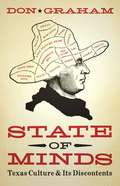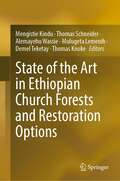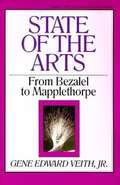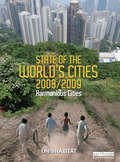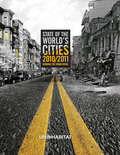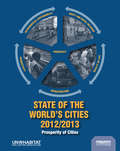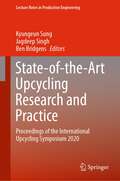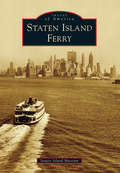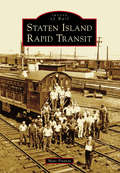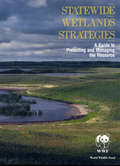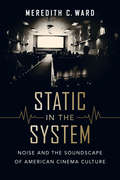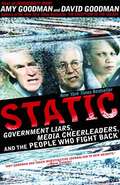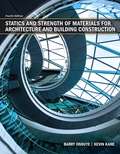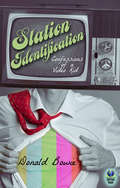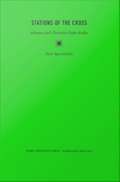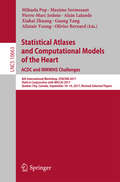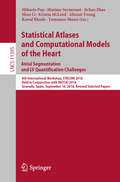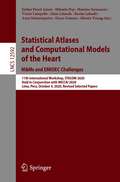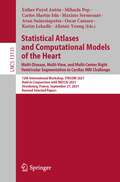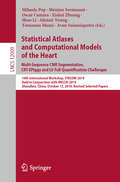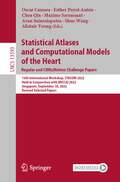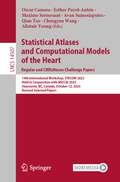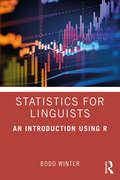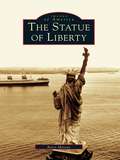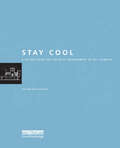- Table View
- List View
State of Minds
by Don GrahamJohn Steinbeck once famously wrote that "Texas is a state of mind. " For those who know it well, however, the Lone Star State is more than one mind-set, more than a collection of cliches, more than a static stereotype. There are minds in Texas, Don Graham asserts, and some of the most important are the writers and filmmakers whose words and images have helped define the state to the nation, the world, and the people of Texas themselves. For many years, Graham has been critiquing Texas writers and films in the pages of Texas Monthly and other publications. In State of Minds, he brings together and updates essays he published between 1999 and 2009 to paint a unique, critical picture of Texas culture. In a strong personal voice--wry, humorous, and ironic--Graham offers his take on Texas literary giants ranging from J. Frank Dobie to Larry McMurtry and Cormac McCarthy and on films such as The Alamo, The Last Picture Show, and Brokeback Mountain. He locates the works he discusses in relation to time and place, showing how they sprang (or not) from the soil of Texas and thereby helped to define Texas culture for generations of readers and viewers--including his own younger self growing up on a farm in Collin County. Never shying from controversy and never dull, Graham's essays in State of Minds demolish the notion that "Texas culture" is an oxymoron.
State of the Art in Ethiopian Church Forests and Restoration Options
by Thomas Schneider Demel Teketay Mengistie Kindu Alemayehu Wassie Mulugeta Lemenih Thomas KnokeThis book, with contributions from leading academics - and including reviews and case studies from Ethiopian Church forests - provides a valuable reference for advanced students and researchers interested in forest and other natural resource management, ecology and ecosystem services as well as restoration options. The book addresses various aspects including a general overview of Ethiopian church forests, the present role and future challenges of church forests. It also discusses their structure and diversity in the context of sustainability and discusses restoration options for surrounding landscapes, under consideration of the circumstances of the land and the needs of surrounding communities. The intended readership includes natural resource professionals in general as well as forestry professionals in particular (practitioners, policymakers, educators and researchers). The book will provide the reader with a good foundation for understanding Ethiopian forest resources and restoration options of degraded landscape.
State of the Arts: From Bezalel to Mapplethorpe (Turning Point Christian Worldview Series)
by Gene VeithArt permeates our culture, yet many have lost all criteria for making aesthetic judgments. This resource chronicles biblical foundations of art as well as the role of Christians in the artistic arena.
State of the World's Cities 2008/9: Harmonious Cities
by Un-HabitatCities are perhaps one of humanity's most complex creations, never finished, never definitive. They are like a journey that never ends. Their evolution is determined by their ascent into greatness or their descent into decline. They are the past, the present and the future. Cities contain both order and chaos. In them reside beauty and ugliness, virtue and vice. They can bring out the best or the worst in humankind. They are the physical manifestation of history and culture and incubators of innovation, industry, technology, entrepreneurship and creativity. Cities are the materialization of humanity's noblest ideas, ambitions and aspirations but when not planned or governed properly, can be the repository of society's ills. Cities drive national economies by creating wealth, enhancing social development and providing employment but they can also be the breeding grounds for poverty, exclusion and environmental degradation. The 21st Century is the Century of the City. Half of humanity now lives in cities, and within the next two decades, 60 per cent of the world's people will reside in urban areas. How can city planners and policymakers harmonize the various interests, diversity and inherent contradictions within cities? What ingredients are needed to create harmony between the physical, social, environmental and cultural aspects of a city and the human beings that inhabit it? This report adopts the concept of Harmonious Cities as a theoretical framework in order to understand today's urban world, and also as an operational tool to confront the most important challenges facing urban areas and their development processes. It recognizes that tolerance, diversity, social justice and good governance, all of which are inter-related, are as important to sustainable urban development as physical planning. It addresses national concerns by searching for solutions at the city level. For that purpose, it focuses on three key areas: spatial or regional harmony, which examines the main drivers of urban growth in the developing world and explores the spatial nuances of economic and social policies; social harmony, which presents and analyzes new data on urban inequalities worldwide and describes the types of shelter deprivations experienced by slum dwellers in developing world regions; and environmental harmony, which examines the role of cities in the climate change debate, and the impact of global warming on the most vulnerable cities. The report also assesses the various intangible assets within cities that contribute to harmony, such as cultural heritage, sense of place and memory and the complex set of social and symbolic relationships that give cities meaning. It argues that these intangible assets represent the soul of the city and are as important for harmonious urban development as tangible assets. Harmony within cities, argues the report, is both a journey and a destination. Published with UN-HABITAT
State of the World's Cities 2010/11: Bridging the Urban Divide
by Un-HabitatThe world's urban population now exceeds the world's rural population. What does this mean for the state of our cities, given the strain this global demographic shift is placing upon current urban infrastructures? Following on from previous State of the World's Cities reports, this edition uses the framework of 'The Urban Divide' to analyse the complex social, political, economic and cultural dynamics of urban environments. In particular, the book focuses on the concept of the 'right to the city' and ways in which many urban dwellers are excluded from the advantages of city life, using the framework to explore links among poverty, inequality, slum formation and economic growth. The volume will be essential reading for all professionals and policymakers in the field, as well as a valuable resource for researchers and students in all aspects of urban development. Published with UN-Habitat.
State of the World's Cities 2012/2013: Prosperity of Cities
by Un HabitatThe city is the home of prosperity. It is the place where human beings find satisfaction of basic needs and access to essential public goods. The city is also where ambitions, aspirations and other material and immaterial aspects of life are realized, providing contentment and happiness. It is a locus at which the prospects of prosperity and individual and collective well-being can be increased. However, when prosperity is restricted to some groups, when it is used to pursue specific interests, or when it is a justification for financial gains for the few to the detriment of the majority, the city becomes the arena where the right to shared prosperity is claimed and fought for. As people in the latter part of 2011 gathered in Cairo’s Tahrir Square, in Madrid’s Puerta del Sol, in front of London’s St Paul’s cathedral, or in New York’s Zuccotti Park, they were not only demanding more equality and inclusion; they were also expressing the need for prosperity to be shared across all segments of society. What this new edition of State of the World’s Cities shows is that prosperity for all has been compromised by a narrow focus on economic growth. UN-Habitat suggests a fresh approach to prosperity beyond the solely economic emphasis, including other vital dimensions such as quality of life, adequate infrastructures, equity and environmental sustainability. The Report proposes a new tool – the City Prosperity Index – together with a conceptual matrix, the Wheel of Prosperity, both of which are meant to assist decision makers to design clear policy interventions. The Report advocates for the need of cities to enhance the public realm, expand public goods and consolidate rights to the 'commons' for all as a way to expand prosperity. This comes in response to the observed trend of enclosing or restricting these goods and commons in enclaves of prosperity, or depleting them through unsustainable use. The Report maps out major policy steps to promote a new type of city – the city of the twenty-first century – that is a 'good', people-centred city. One that is capable of integrating the tangible and more intangible aspects of prosperity, and in the process shedding off the inefficient, unsustainable forms and functionalities of the city of the previous century. By doing this, UN-Habitat plays a pivotal role in ensuring that urban planning, legal, regulatory and institutional frameworks become instruments of prosperity and well-being.
State-of-the-Art Upcycling Research and Practice: Proceedings of the International Upcycling Symposium 2020 (Lecture Notes in Production Engineering)
by Jagdeep Singh Kyungeun Sung Ben BridgensThis book presents the proceedings of the first International Upcycling Symposium 2020, held on 4th September 2020 at De Montfort University (DMU) in Leicester, UK (online), as a joint effort between DMU, Lund University, Nottingham Trent University and Newcastle University. This book presents state of the art of research and practice in “upcycling” at the international level.The subject of this book, upcycling, is a term to describe the processes of creating or modifying a product from used or waste materials, components and products, which is of equal or higher quality or value than the compositional elements. This book describes new theories, approaches and scientific research findings related to upcycling and presents examples of upcycling practice, across multiple sectors, scales and contexts. Bringing together research from over 35 multidisciplinary experts, the book discusses state-of-the-art knowledge and practices on upcycling in different geographical, economic, socio-cultural and technological contexts at an international level. Readers will gain fundamental understanding of upcycling with its varied definitions and forms across sectors and scales, and to be informed of the latest upcycling research and practices including valuable ideas, theories, projects, experiences and insights by global experts.
Staten Island Ferry (Images of America)
by Staten Island MuseumConsidered the "Best Ride in New York City," the Staten Island Ferry has been immortalized over the years in art, literature, film, and music. In the 19th century, cross-bay ferry riders complained of dangerous and unreliable private service. On October 25, 1905, the newly incorporated City of New York assumed ownership of the service, and the Borough class--the Brooklyn, Bronx, Richmond, Queens, and Manhattan ferryboats--was introduced. These were the largest ferries on the East Coast and made the crossing in 22.5 minutes. Today, the ferry is recognized as a New York icon and a symbol of the borough. A favorite destination for tourists, the Staten Island Ferry carries 22 million passengers annually. On a typical day, 109 trips move about 70,000 people across the harbor, making the Staten Island Ferry one of the most reliable forms of mass transit in the city.
Staten Island Rapid Transit
by Marc PitanzaStaten Island's first railroad began in 1860 as a passenger line connecting towns along the island's eastern shore, with ferry service from Vanderbilt's Landing to Manhattan. The Staten Island Rapid Transit was a second line, built in 1885. During the 19th century, major eastern trunk railroads competed for the New York freight market. The Baltimore & Ohio Railroad (B&O) was a latecomer but saw opportunity with Staten Island in 1886, buying interest in both railroads. The B&O took control of the island's passenger service and turned it into a thriving commuter railroad with three branches and nearly 40 stations, forever changing transportation in the borough. Reaching Staten Island from Cranford, New Jersey, the B&O built a major freight yard at Arlington and a waterfront terminal at St. George. The railroad's customers ran the gamut from large industries like Procter & Gamble to small one-carload coal dealerships. By 1971, the cash-strapped B&O sold the passenger service to the New York City Transit Authority (NYCTA), and by 1985, the B&O had left New York for good.
Statewide Wetlands Strategies: A Guide To Protecting And Managing The Resource
by Mark Rorner World Wildlife FundStatewide Wetlands Strategies offers comprehensive strategies that draw upon all levels of government and the private sector to focus and coordinate efforts to work toward the goal of no-net-loss of wetlands.
Static in the System: Noise and the Soundscape of American Cinema Culture (California Studies in Music, Sound, and Media #1)
by Dr Meredith C. WardIn this rich study of noise in American film-going culture, Meredith C. Ward shows how aurality can reveal important fissures in American motion picture history, enabling certain types of listening cultures to form across time. Connecting this history of noise in the cinema to a greater sonic culture, Static in the System shows how cinema sound was networked into a broader constellation of factors that affected social power, gender, sexuality, class, the built environment, and industry, and how these factors in turn came to fruition in cinema's soundscape. Focusing on theories of power as they manifest in noise, the history of noise in electro-acoustics with the coming of film sound, architectural acoustics as they were manipulated in cinema theaters, and the role of the urban environment in affecting mobile listening and the avoidance of noise, Ward analyzes the powerful relationship between aural cultural history and cinema's sound theory, proving that noise can become a powerful historiographic tool for the film historian.
Static: Government Liars, Media Cheerleaders, and the People Who Fight Back
by Amy GoodmanTorture. Kidnapping. Bogus wars. Illegal wiretapping. Propaganda. Spies in the newsrooms. Oil profiteers. Soldiers who won't fight. Mothers of fallen soldiers Who will.In Static, the bestselling brother-sister team of Amy Goodman, host of Democracy Now!, and investigative journalist David Goodman takes on government liars, corporate profiteers, and the media that have acted as their cheerleaders. The authors cut through the official static to show the truth about war, torture, and government control of the media. Static breaks the sound barrier to present the voices of dissidents, activists, and others who are often frozen out of official debate.Read Static. Become informed. Fight back. Defend democracy.
Statics and Strength of Materials for Architecture and Building Construction
by Barry S. Onouye Kevin KaneStatics and Strength of Materials for Architecture and Building Construction, Fourth Edition, offers students an accessible, visually oriented introduction to structural theory that doesn't rely on calculus. KEY FEATURES: Instead, illustrations and examples of building frameworks and components enable students to better visualize the connection between theoretical concepts and the experiential nature of real buildings and materials. This new edition includes fully worked examples in each chapter, a companion website with extra practice problems, and expanded treatment of load tracing.
Station Identification: Confessions of a Video Kid
by Donald BowieThe unique memoir of one man&’s life-long relationship with TV, from childhood with Howdy Doody to the heartbreaking decision to get rid of his set. In 1980, author and professor Donald Bowie was in his thirties and about to give up the most enduring relationship in his life—his television set. In Station Identification, he recounts his long and strange friendship with TV from the unrestrained naughtiness of Howdy Doody to the last episode of The Mary Tyler Moore Show. Over the years, TV becomes his family, his friends, his classroom, and, ultimately, his undoing. Grappling with the urges of puberty, what seems confusing in life is easily understood while watching Elly May Clampett on The Beverly Hillbillies. Years later, after a wonderful night on the town, Donald brings his date home to watch a rerun of The Honeymooners—something close to having her meet the folks. From his suspicions of snobbery among the Sesame Street gang to his observations of the first made-for-TV president, John F. Kennedy, Donald offers a witty portrait of life in the warm glow of his most constant companion.
Stations of the Cross: Adorno and Christian Right Radio
by Paul ApostolidisSince the 1970s, American society has provided especially fertile ground for the growth of the Christian right and its influence on both political and cultural discourse. In Stations of the Cross political theorist Paul Apostolidis shows how a critical component of this movement's popular culture--evangelical conservative radio--interacts with the current U. S. political economy. By examining in particular James Dobson's enormously influential program, Focus on the Family--its messages, politics, and effects--Apostolidis reveals the complex nature of contemporary conservative religious culture. Public ideology and institutional tendencies clash, the author argues, in the restructuring of the welfare state, the financing of the electoral system, and the backlash against women and minorities. These frictions are nowhere more apparent than on Christian right radio. Reinvigorating the intellectual tradition of the Frankfurt School, Apostolidis shows how ideas derived from early critical theory--in particular that of Theodor W. Adorno--can illuminate the political and social dynamics of this aspect of contemporary American culture. He uses and reworks Adorno's theories to interpret the nationally broadcast Focus on the Family, revealing how the cultural discourse of the Christian right resonates with recent structural transformations in the American political economy. Apostolidis shows that the antidote to the Christian right's marriage of religious and market fundamentalism lies not in a reinvocation of liberal fundamentals, but rather depends on a patient cultivation of the affinities between religion's utopian impulses and radical, democratic challenges to the present political-economic order. Mixing critical theory with detailed analysis, Stations of the Cross provides a needed contribution to sociopolitical studies of mass movements and will attract readers in sociology, political science, philosophy, and history.
Statistical Atlases and Computational Models of the Heart. ACDC and MMWHS Challenges: 8th International Workshop, Stacom 2017, Held In Conjunction With Miccai 2017, Quebec City, Canada September 10 - 14, 2017 Revised Selected Papers (Lecture Notes in Computer Science #10663)
by Mihaela Pop Maxime Sermesant Alistair Young Pierre-Marc Jodoin Alain Lalande Xiahai Zhuang Guang Yang Olivier BernardThis book constitutes the thoroughly refereed post-workshop proceedings of the 8th International Workshop on Statistical Atlases and Computational Models of the Heart: ACDC and MMWHS Challenges 2017, held in conjunction with MICCAI 2017, in Quebec, Canada, in September 2017. The 27 revised full workshop papers were carefully reviewed and selected from 35 submissions. The papers cover a wide range of topics computational imaging and modelling of the heart, as well as statistical cardiac atlases. The topics of the workshop included: cardiac imaging and image processing, atlas construction, statistical modelling of cardiac function across different patient populations, cardiac computational physiology, model customization, atlas based functional analysis, ontological schemata for data and results, integrated functional and structural analyses, as well as the pre-clinical and clinical applicability of these methods. Besides regular contributing papers, additional efforts of STACOM workshop were also focused on two challenges: ACDC and MM-WHS.
Statistical Atlases and Computational Models of the Heart. Atrial Segmentation and LV Quantification Challenges: 9th International Workshop, STACOM 2018, Held in Conjunction with MICCAI 2018, Granada, Spain, September 16, 2018, Revised Selected Papers (Lecture Notes in Computer Science #11395)
by Shuo Li Tommaso Mansi Mihaela Pop Kawal Rhode Maxime Sermesant Alistair Young Kristin McLeod Jichao ZhaoThis book constitutes the thoroughly refereed post-workshop proceedings of the 9th International Workshop on Statistical Atlases and Computational Models of the Heart: Atrial Segmentation and LV Quantification Challenges, STACOM 2018, held in conjunction with MICCAI 2018, in Granada, Spain, in September 2018. The 52 revised full workshop papers were carefully reviewed and selected from 60 submissions. The topics of the workshop included: cardiac imaging and image processing, machine learning applied to cardiac imaging and image analysis, atlas construction, statistical modelling of cardiac function across different patient populations, cardiac computational physiology, model customization, atlas based functional analysis, ontological schemata for data and results, integrated functional and structural analyses, as well as the pre-clinical and clinical applicability of these methods.
Statistical Atlases and Computational Models of the Heart. M&Ms and EMIDEC Challenges: 11th International Workshop, STACOM 2020, Held in Conjunction with MICCAI 2020, Lima, Peru, October 4, 2020, Revised Selected Papers (Lecture Notes in Computer Science #12592)
by Oscar Camara Mihaela Pop Maxime Sermesant Alistair Young Alain Lalande Avan Suinesiaputra Esther Puyol Anton Victor Campello Karim LekadirThis book constitutes the proceedings of the 11th International Workshop on Statistical Atlases and Computational Models of the Heart, STACOM 2020, as well as two challenges: M&Ms - The Multi-Centre, Multi-Vendor, Multi-Disease Segmentation Challenge, and EMIDEC - Automatic Evaluation of Myocardial Infarction from Delayed-Enhancement Cardiac MRI Challenge. The 43 full papers included in this volume were carefully reviewed and selected from 70 submissions. They deal with cardiac imaging and image processing, machine learning applied to cardiac imaging and image analysis, atlas construction, artificial intelligence, statistical modelling of cardiac function across different patient populations, cardiac computational physiology, model customization, atlas based functional analysis, ontological schemata for data and results, integrated functional and structural analyses, as well as the pre-clinical and clinical applicability of these methods.
Statistical Atlases and Computational Models of the Heart. Multi-Disease, Multi-View, and Multi-Center Right Ventricular Segmentation in Cardiac MRI Challenge: 12th International Workshop, STACOM 2021, Held in Conjunction with MICCAI 2021, Strasbourg, France, September 27, 2021, Revised Selected Papers (Lecture Notes in Computer Science #13131)
by Oscar Camara Mihaela Pop Maxime Sermesant Alistair Young Avan Suinesiaputra Karim Lekadir Esther Puyol Antón Carlos Martín-IslaThis book constitutes the proceedings of the 12th International Workshop on Statistical Atlases and Computational Models of the Heart, STACOM 2021, as well as the M&Ms-2 Challenge: Multi-Disease, Multi-View and Multi-Center Right Ventricular Segmentation in Cardiac MRI Challenge.The 25 regular workshop papers included in this volume were carefully reviewed and selected after being revised. They deal with cardiac imaging and image processing, machine learning applied to cardiac imaging and image analysis, atlas construction, artificial intelligence, statistical modelling of cardiac function across different patient populations, cardiac computational physiology, model customization, atlas based functional analysis, ontological schemata for data and results, integrated functional and structural analyses, as well as the pre-clinical and clinical applicability of these methods. In addition, 15 papers from the M&MS-2 challenge are included in this volume. The Multi-Disease, Multi-View & Multi-Center Right Ventricular Segmentation in Cardiac MRI Challenge (M&Ms-2) is focusing on the development of generalizable deep learning models for the Right Ventricle that can maintain good segmentation accuracy on different centers, pathologies and cardiac MRI views. There was a total of 48 submissions to the workshop.
Statistical Atlases and Computational Models of the Heart. Multi-Sequence CMR Segmentation, CRT-EPiggy and LV Full Quantification Challenges: 10th International Workshop, STACOM 2019, Held in Conjunction with MICCAI 2019, Shenzhen, China, October 13, 2019, Revised Selected Papers (Lecture Notes in Computer Science #12009)
by Shuo Li Oscar Camara Tommaso Mansi Mihaela Pop Maxime Sermesant Alistair Young Xiahai Zhuang Avan SuinesiaputraThis book constitutes the thoroughly refereed post-workshop proceedings of the 10th International Workshop on Statistical Atlases and Computational Models of the Heart: Atrial Segmentation and LV Quantification Challenges, STACOM 2019, held in conjunction with MICCAI 2019, in Shenzhen, China, in October 2019. The 42 revised full workshop papers were carefully reviewed and selected from 76 submissions. The topics of the workshop included: cardiac imaging and image processing, machine learning applied to cardiac imaging and image analysis, atlas construction, statistical modelling of cardiac function across different patient populations, cardiac computational physiology, model customization, atlas based functional analysis, ontological schemata for data and results, integrated functional and structural analyses, as well as the pre-clinical and clinical applicability of these methods.
Statistical Atlases and Computational Models of the Heart. Regular and CMRxMotion Challenge Papers: 13th International Workshop, STACOM 2022, Held in Conjunction with MICCAI 2022, Singapore, September 18, 2022, Revised Selected Papers (Lecture Notes in Computer Science #13593)
by Shuo Wang Oscar Camara Maxime Sermesant Alistair Young Avan Suinesiaputra Chen Qin Esther Puyol-AntónThis book constitutes the proceedings of the 13th International Workshop on Statistical Atlases and Computational Models of the Heart, STACOM 2022, held in conjunction with the 25th MICCAI conference. The 34 regular workshop papers included in this volume were carefully reviewed and selected after being revised and deal with topics such as: common cardiac segmentation and modelling problems to more advanced generative modelling for ageing hearts, learning cardiac motion using biomechanical networks, physics-informed neural networks for left atrial appendage occlusion, biventricular mechanics for Tetralogy of Fallot, ventricular arrhythmia prediction by using graph convolutional network, and deeper analysis of racial and sex biases from machine learning-based cardiac segmentation. In addition, 14 papers from the CMRxMotion challenge are included in the proceedings which aim to assess the effects of respiratory motion on cardiac MRI (CMR) imaging quality and examine the robustness of segmentation models in face of respiratory motion artefacts. A total of 48 submissions to the workshop was received.
Statistical Atlases and Computational Models of the Heart. Regular and CMRxRecon Challenge Papers: 14th International Workshop, STACOM 2023, Held in Conjunction with MICCAI 2023, Vancouver, BC, Canada, October 12, 2023, Revised Selected Papers (Lecture Notes in Computer Science #14507)
by Oscar Camara Maxime Sermesant Alistair Young Avan Suinesiaputra Esther Puyol-Antón Qian Tao Chengyan WangThis book constitutes the proceedings of the 14th International Workshop on Statistical Atlases and Computational Models of the Heart, STACOM 2023, as well as the Cardiac MRI Reconstruction Challenge, CMRxRecon Challenge. There was a total of 53 submissions to the workshop. The 24 regular workshop papers included in this volume were carefully reviewed and selected from 29 paper submissions. They deal with cardiac segmentation, modelling, strain quantification, registration, statistical shape analysis, and quality control. In addition, 21 papers from the CMRxRecon challenge are included in this volume. They focus on fast CMR image reconstruction and provide a benchmark dataset that enables the broader research community to promote advances in this area of research.
Statistics for Linguists: An Introduction Using R
by Bodo WinterStatistics for Linguists: An Introduction Using R is the first statistics textbook on linear models for linguistics. The book covers simple uses of linear models through generalized models to more advanced approaches, maintaining its focus on conceptual issues and avoiding excessive mathematical details. It contains many applied examples using the R statistical programming environment. Written in an accessible tone and style, this text is the ideal main resource for graduate and advanced undergraduate students of Linguistics statistics courses as well as those in other fields, including Psychology, Cognitive Science, and Data Science.
Statue of Liberty, The (Images of America)
by Barry MorenoThe Statue of Liberty is an awesome visual journey that begins with the fantastic proposal of a French professor to give the United States a monument to commemorate the Revolutionary War alliance between the thirteen colonies and France. It documents the gift's taking symbolic form of the ancient goddess of liberty and its designation as the tallest metal statue in the world. Highlights include Liberty's construction history, her changing symbolism over the years, and her use in popular advertising and political activism. Her upraised arm has saluted scores of ships as they have passed by. Her dignity has welcomed Americans returning home from foreign parts and has given hope to newcomers seeking a fresh beginning in the land of liberty.
Stay Cool: A Design Guide for the Built Environment in Hot Climates
by Holger Koch-NielsenIn hot dry or warm humid climates, more than half of the urban peak load of energy consumption is used to satisfy air-conditioning demands alone. Since the urbanization rate in developing countries is extreme, the pressure placed on energy resources to satisfy the future requirements of the built environment will be great, unless new, more cost-effective measures can be introduced. Stay Cool is an essential guide for planning and design using active design principles and passive means to satisfy human comfort requirements specifically in these climate zones, based on examples of traditional and modern constructions. The book demonstrates how a design strategy for urban environments and individual buildings, incorporating naturally occurring resources and specific energy-efficient technologies, can create a location, form and structure that promote significant energy-savings. Such strategies can be applied to low cost housing, or indeed to any other buildings, in order to improve comfort with passive means and low energy budgets. Following an outline of climatic issues, characteristics and thermal comfort requirements, the book details the available techniques and technologies that can be used to shape both built and external environments, the building envelope, material selections and natural ventilation and cooling methods to satisfy both human requirements and the need for energy efficiency. It also includes an active design checklist and summary of available design checking tools, a rehabilitation guide for existing urban, building and external environments, and solar charts. Planners, architects, engineers, technicians and building designers will find Stay Cool an inspirational guide and an essential reference when working with planning and design of the built environment in hot dry and warm humid climate zones. It will also be of benefit to students, academics and researchers with an interest in sustainable and energy-efficient architecture techniques and practice.
